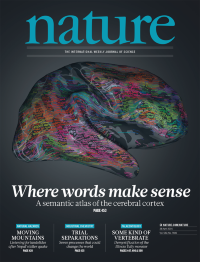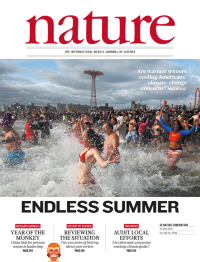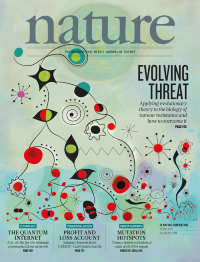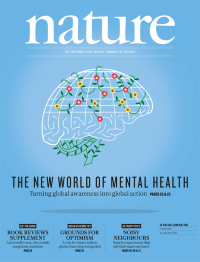Volume 532
-
No. 7600 28 April 2016
It is thought that the meanings of words and language are represented in a semantic system distributed across much of the cerebral cortex. However, little is known about the detailed functional and anatomical organization of this network. Alex Huth, Jack Gallant and colleagues set out to map the functional representations of semantic meaning in the human brain using voxel-based modelling of functional magnetic resonance imaging (fMRI) recordings made while subjects listened to natural narrative speech. They find that each semantic concept is represented in multiple semantic areas, and each semantic area represents multiple semantic concepts. The recovered semantic maps are largely consistent across subjects, however, providing the basis for a semantic atlas that can be used for future studies of language processing. An interactive version of the atlas can be explored at http://gallantlab.org/huth2016. The cover shows the cortical surface of one subject, overlaid with words predicted to cause particularly strong responses at the corresponding cortical location. Word colours indicate semantic categories: for example, green words are mostly visual and tactile concepts, and red words are mostly social concepts. White lines show the outlines of previously known regions of interest. Cover: Alex Huth
-
No. 7599 21 April 2016
Coney Island Polar Bear Clubs New Years Day swim on 1 January 2016. Its like summer out there�, said one participant. Future climate change is projected to render many parts of the world increasingly inhospitable to human habitation. Why then, has it been so difficult to marshal broad public support for climate mitigation? Patrick Egan and Megan Mullin use population-weighted analysis of US weather conditions to show that most Americans are now experiencing milder winters, without substantially more uncomfortable summers or other negative changes. Egan and Mullin suggest that current weather patterns are serving as a poor source of motivation for the US population to demand a policy response to climate change. Things could change though. Projections of future US weather indicate that conditions will probably worsen, so public concern may rise. Cover: Reuters/Andrew Kelly
-
No. 7598 14 April 2016
An illustration of tumour cells� battle for survival. Treatment-resistant tumours are subject to the same rules of natural selection as any other living thing. Clinicians are increasingly trying to put that knowledge to use (News Feature, page 166). Also in this cancer-focused issue, the rapidly changing field of cancer immunotherapy (News Feature, page 162), and the latest developments in the technology behind liquid biopsies, a promising approach to cancer diagnosis and monitoring (Technology, page 269). The Research pages include two papers and an associated News & Views reporting high mutation rates at active promoters in cancer (pages 181, 259 & 264). Cover: Nic Spencer / Nature
-
No. 7597 7 April 2016
Mental-health disorders are the leading causes of disability worldwide, and the efforts of the World Health Organization and other international bodies in recent years have succeeded in raising political awareness of the fact. In a Comment piece on page 25 of this issue of Nature, Pamela Collins and Shekhar Saxena underline the importance of harnessing that global concern into global action. To that end, they offer six practical suggestions � encompassing logistics, training, clinical interventions and public health measures � for how we can meet the mental-health needs of vulnerable people everywhere. One high-profile growth area is that of smart-phone apps. But as pointed out in a News Feature on page 20, app technology is moving a lot faster than the medical science supporting it. Cover art: Oliver Munday




